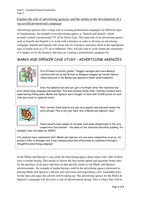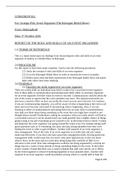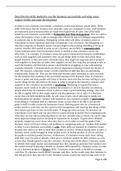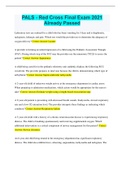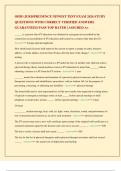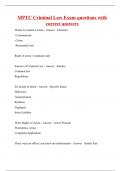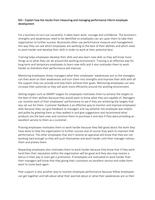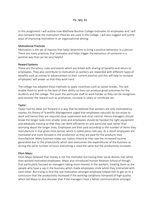Task 1 – produce a report explaining to people their rights under the Consumer Rights Act 2015 and how they are
protected in given situations.
- Apply the law on sale of goods showing how consumers are protected in given situations (P1)
- Explain how consumers are protected in contracts for the supply of goods and/or services (P2)
Before the law, there were 3 other acts that would have protected the consumer in regard to the goods they would
have been buying, these acts, included, 1) Sale of Good Act 1979 (which protected the consumer, it required that
goods need to be as described, with acceptable standards, which make them fit for its purpose). 2) Unfair terms in
Consumer Contracts Regulations 1999 (again this act protected the consumer, from any unfair trading standards
listed within a contract made between the consumer and business). And the last act 3) Supply of Goods and Services
Act 1982 (which required a business to provide a service, which is of reasonable care and skill, completed within a
reasonable time period and with a reasonable price)
Sale of goods – Consumer Rights Act 2015
The Consumer Rights Act 2015 came into power on 1 October 2015. It relates to customers purchasing merchandise
from a business. The Act united a significant part of the past enactment from the Sale of Goods Act 1979, just as
acquainting some new principles with make shopper rights more explicit and pertinent to the 21st century.
S.2 – Definitions
Outlined under s.2 of the Consumer Rights Act 2015, covers the offer of merchandise and the privileges of the
purchaser. The Act characterizes consumers as people purchasing products for individual use.
A business is characterized in s2 as an individual representing purposes identifying with that individual's exchange
business, specialty or calling, often referred to as a trader.
S.3 – Goods
In s.3 the Consumer Rights Act 2015, it applies to the agreements a dealer (business) uses to supply merchandise to
a shopper.
Merchandise is characterized in section 3 of the Act and it states that any substantial removable things. The
guidelines apply to both new and recycled merchandise purchased from a business. The Consumer Rights Act 2015
just applies to products sold by a business to a person. It does not matter to the offer of products by one individual
to another person, for which the term ‘caveat emptor’ (let the buyer beware) applies.
S.9 – Satisfactory quality
S.9 of the Consumer Rights Act covers the nature of products. Acceptable quality depends on what a sensible
individual would expect of the products considering elements like the value, appearance, wellbeing, and toughness
of the thing. On the off chance that there has been a break of value, the purchaser has rights under the Consumer
Rights Act 2015. The shopper can make a move under this inferred term if the products do not work as expected.
On the off chance that the merchant tells the purchaser that there is a possible issue with the item, and the
purchaser keeps on buying the thing, there can be no later grievance in the event that it is more costly to fix the
thing. This was found in Bartlett v Sidney Marcus Ltd (1965).
Bartlett v Sidney Marcus Ltd (1965)
The claimant bought a recycled Jaguar vehicle from a vehicle vendor. The seller told the client that the grasp was
blemished and that this was a minor fix costing a couple of pounds. He gave the claimant the decision of either
accepting the vehicle as it was and thumping some cash off the cost, or he would fix it and charge the maximum. The
Subsidiary Diploma in Applied Law
Unit 7: Consumer Law
Viliam Reis: B000871
, buyer decided to take the vehicle with the blame and get the markdown. Buyer later found that the issue would cost
substantially more than he initially suspected to fix.
The court concluded that the seller had carried the deformity to the consideration of the client and consequently the
asker reserved no option to say that the vehicle was not of agreeable quality.
Legitimate guideline – if an imperfection has been brought to the purchaser's consideration before the deal was
finished, the purchaser has not rebound for that deformity.
S.10 – Fitness for purpose
The merchandise should be good for the reason for which they are made or expected. On the off chance that the
products do not work as expected, they will not be good for their motivation and move can be made by the
purchaser for penetrate of this term. A model is given on account of Baldry v Marshall (1925).
Baldry v Marshall (1925)
The purchaser requested that the dealer supply him with a quick, adaptable, and effortlessly oversaw vehicle that
would be agreeable and reasonable for conventional visiting purposes. The merchant provided a Bugatti hustling
vehicle, which was not under any condition appropriate. The court concluded that the purchaser was qualified for
reject the Bugatti.
Legitimate rule – there was a breach of the qualification for reason term.
Ordinarily, if the merchandise does not work as expected there will be breach of both the good quality term and the
readiness for reason term. However long the purchaser can demonstrate at any rate one of the inferred terms has
been broken, they will have rights under the Consumer Rights Act 2015.
S.11 – Description
The merchandise should coordinate with their depiction – this can incorporate its tone or make. On the off chance
that the vender tells the purchaser the products will be equivalent to any example appeared, the merchandise when
gotten ought to adjust to the example that has been seen. An illustration of this is appeared in Re Moore and
Landauer (1921).
Re Moore and Landauer (1921)
An agreement for the offer of 3100 tons of peaches depicted the tins as being stuffed in instances of 30. At the point
when they showed up, the tins were pressed in instances of 24. An aggregate of 3100 tins were provided. The court
concluded that the buyer was qualified for reject the products since they were not as depicted. This can be viewed
as an unforgiving choice as the buyer got the right number of tins, despite the fact that erroneously pressed.
Legitimate guideline – if the merchandise does not relate precisely with the concurred portrayal, there will be a
break of a suggested term.
There can be a deal by depiction regardless of whether the purchaser examines the thing prior to buying it, as seen
in Beale v Taylor (1967).
Beale v Taylor (1967)
Taylor publicized a vehicle, portraying it as 'white, 1961, Herald convertible'. Depending on that depiction, Beale
examined the vehicle. As he did not have a driving permit, he did not step through an exam drive, however sat in the
front seat. He saw a metallic circle on the back of the vehicle with the figure '1200' on it. He purchased the vehicle
trusting it to be the 1961 model. After he got his permit, he found the vehicle unsuitable to drive. At the point when
he had it analysed, he was informed that the vehicle was comprised of two vehicles welded together; the front part
was a 948 model while the back partition was the 1200 model.
Subsidiary Diploma in Applied Law
Unit 7: Consumer Law
Viliam Reis: B000871
protected in given situations.
- Apply the law on sale of goods showing how consumers are protected in given situations (P1)
- Explain how consumers are protected in contracts for the supply of goods and/or services (P2)
Before the law, there were 3 other acts that would have protected the consumer in regard to the goods they would
have been buying, these acts, included, 1) Sale of Good Act 1979 (which protected the consumer, it required that
goods need to be as described, with acceptable standards, which make them fit for its purpose). 2) Unfair terms in
Consumer Contracts Regulations 1999 (again this act protected the consumer, from any unfair trading standards
listed within a contract made between the consumer and business). And the last act 3) Supply of Goods and Services
Act 1982 (which required a business to provide a service, which is of reasonable care and skill, completed within a
reasonable time period and with a reasonable price)
Sale of goods – Consumer Rights Act 2015
The Consumer Rights Act 2015 came into power on 1 October 2015. It relates to customers purchasing merchandise
from a business. The Act united a significant part of the past enactment from the Sale of Goods Act 1979, just as
acquainting some new principles with make shopper rights more explicit and pertinent to the 21st century.
S.2 – Definitions
Outlined under s.2 of the Consumer Rights Act 2015, covers the offer of merchandise and the privileges of the
purchaser. The Act characterizes consumers as people purchasing products for individual use.
A business is characterized in s2 as an individual representing purposes identifying with that individual's exchange
business, specialty or calling, often referred to as a trader.
S.3 – Goods
In s.3 the Consumer Rights Act 2015, it applies to the agreements a dealer (business) uses to supply merchandise to
a shopper.
Merchandise is characterized in section 3 of the Act and it states that any substantial removable things. The
guidelines apply to both new and recycled merchandise purchased from a business. The Consumer Rights Act 2015
just applies to products sold by a business to a person. It does not matter to the offer of products by one individual
to another person, for which the term ‘caveat emptor’ (let the buyer beware) applies.
S.9 – Satisfactory quality
S.9 of the Consumer Rights Act covers the nature of products. Acceptable quality depends on what a sensible
individual would expect of the products considering elements like the value, appearance, wellbeing, and toughness
of the thing. On the off chance that there has been a break of value, the purchaser has rights under the Consumer
Rights Act 2015. The shopper can make a move under this inferred term if the products do not work as expected.
On the off chance that the merchant tells the purchaser that there is a possible issue with the item, and the
purchaser keeps on buying the thing, there can be no later grievance in the event that it is more costly to fix the
thing. This was found in Bartlett v Sidney Marcus Ltd (1965).
Bartlett v Sidney Marcus Ltd (1965)
The claimant bought a recycled Jaguar vehicle from a vehicle vendor. The seller told the client that the grasp was
blemished and that this was a minor fix costing a couple of pounds. He gave the claimant the decision of either
accepting the vehicle as it was and thumping some cash off the cost, or he would fix it and charge the maximum. The
Subsidiary Diploma in Applied Law
Unit 7: Consumer Law
Viliam Reis: B000871
, buyer decided to take the vehicle with the blame and get the markdown. Buyer later found that the issue would cost
substantially more than he initially suspected to fix.
The court concluded that the seller had carried the deformity to the consideration of the client and consequently the
asker reserved no option to say that the vehicle was not of agreeable quality.
Legitimate guideline – if an imperfection has been brought to the purchaser's consideration before the deal was
finished, the purchaser has not rebound for that deformity.
S.10 – Fitness for purpose
The merchandise should be good for the reason for which they are made or expected. On the off chance that the
products do not work as expected, they will not be good for their motivation and move can be made by the
purchaser for penetrate of this term. A model is given on account of Baldry v Marshall (1925).
Baldry v Marshall (1925)
The purchaser requested that the dealer supply him with a quick, adaptable, and effortlessly oversaw vehicle that
would be agreeable and reasonable for conventional visiting purposes. The merchant provided a Bugatti hustling
vehicle, which was not under any condition appropriate. The court concluded that the purchaser was qualified for
reject the Bugatti.
Legitimate rule – there was a breach of the qualification for reason term.
Ordinarily, if the merchandise does not work as expected there will be breach of both the good quality term and the
readiness for reason term. However long the purchaser can demonstrate at any rate one of the inferred terms has
been broken, they will have rights under the Consumer Rights Act 2015.
S.11 – Description
The merchandise should coordinate with their depiction – this can incorporate its tone or make. On the off chance
that the vender tells the purchaser the products will be equivalent to any example appeared, the merchandise when
gotten ought to adjust to the example that has been seen. An illustration of this is appeared in Re Moore and
Landauer (1921).
Re Moore and Landauer (1921)
An agreement for the offer of 3100 tons of peaches depicted the tins as being stuffed in instances of 30. At the point
when they showed up, the tins were pressed in instances of 24. An aggregate of 3100 tins were provided. The court
concluded that the buyer was qualified for reject the products since they were not as depicted. This can be viewed
as an unforgiving choice as the buyer got the right number of tins, despite the fact that erroneously pressed.
Legitimate guideline – if the merchandise does not relate precisely with the concurred portrayal, there will be a
break of a suggested term.
There can be a deal by depiction regardless of whether the purchaser examines the thing prior to buying it, as seen
in Beale v Taylor (1967).
Beale v Taylor (1967)
Taylor publicized a vehicle, portraying it as 'white, 1961, Herald convertible'. Depending on that depiction, Beale
examined the vehicle. As he did not have a driving permit, he did not step through an exam drive, however sat in the
front seat. He saw a metallic circle on the back of the vehicle with the figure '1200' on it. He purchased the vehicle
trusting it to be the 1961 model. After he got his permit, he found the vehicle unsuitable to drive. At the point when
he had it analysed, he was informed that the vehicle was comprised of two vehicles welded together; the front part
was a 948 model while the back partition was the 1200 model.
Subsidiary Diploma in Applied Law
Unit 7: Consumer Law
Viliam Reis: B000871


